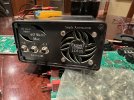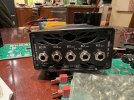JohnH
Well-Known Member
ok, for a test, maybe you could plug in a 16 ohm cab, and the 16 Ohm M2 both in parallel into the amp? Then you have an 8 Ohm load and about -3dB attenuation on the speaker. For this use, the M2 can be set to max attenuation with no speaker and is then acting as a 16 Ohm load.





